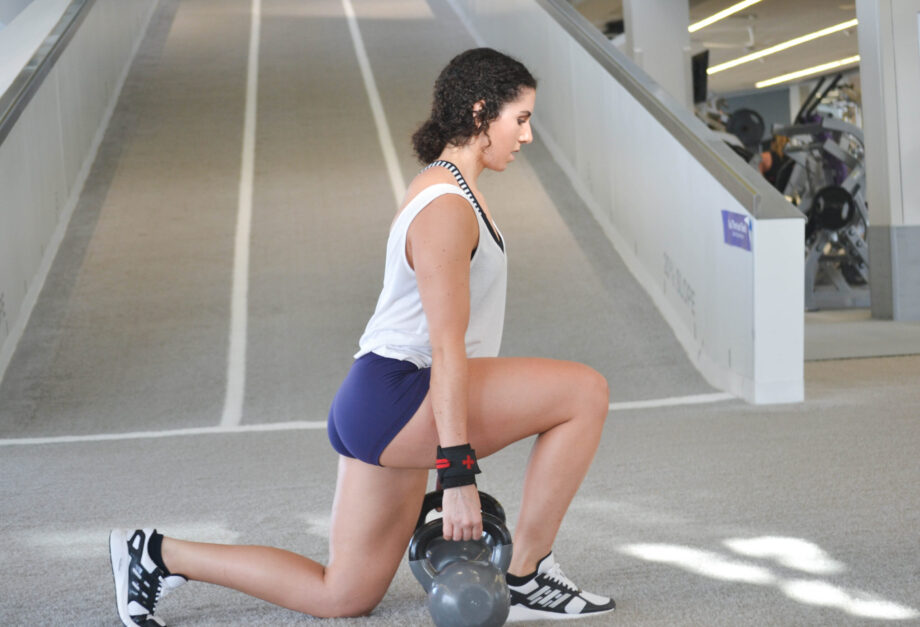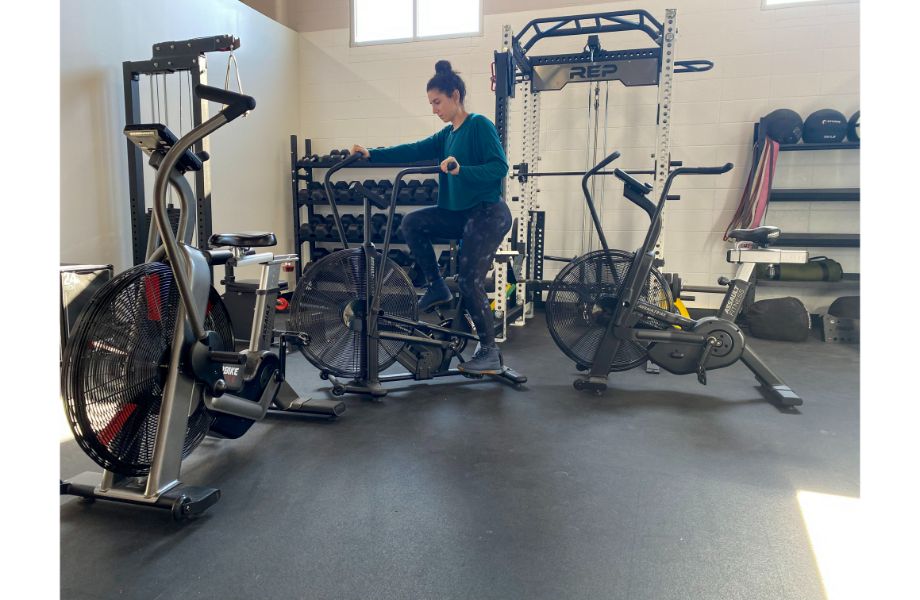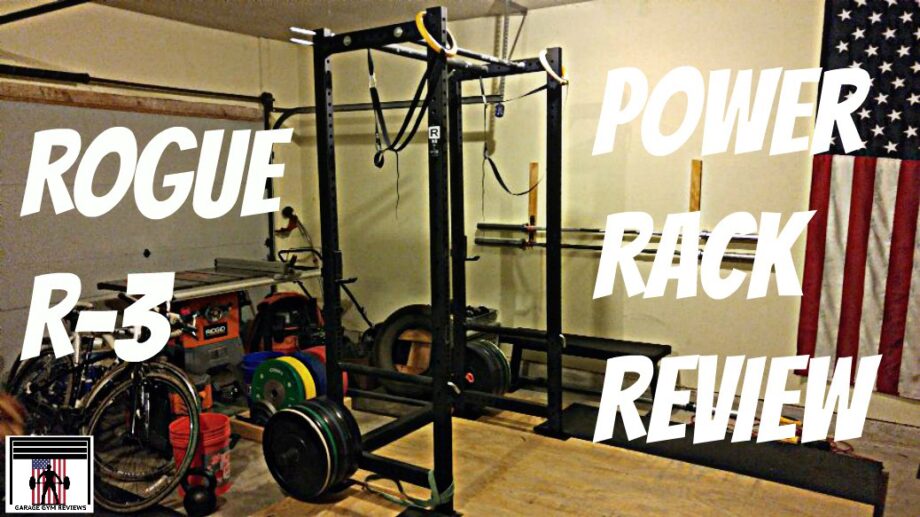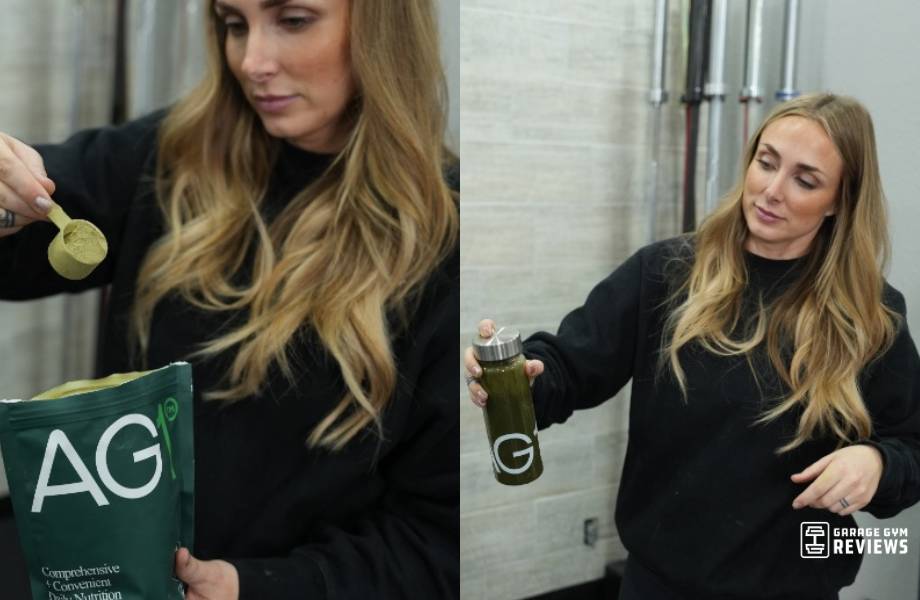The kettlebell is one of the most versatile pieces of gym equipment. A single kettlebell offers incredible exercise diversity, giving you a full-body workout without the need for bulky barbells, dumbbells, or specialized machines.
So, when it comes to your leg day, all you need is a kettlebell, and you are golden. We’ve got 11 exercises that’ll crush your quads, hit your hammies, and get those glutes in great shape.
Kate Meier, NASM-CPT, USAW-L1, CF-L1, and GGR Head of Content, walks us through each movement, providing professional pointers on proper form as well as dynamic kettlebell leg workouts to help you build muscle, build strength, and improve your power output.
RELATED: The 11 Best Kettlebells For Your Home Workout
Best Kettlebell Leg Exercises
First, let’s go over the best kettlebell exercises for your legs!
Kettlebell Goblet Squat
Why we like it: The goblet squat challenges your quadriceps, glutes, and calves, like most squat variations, but the positioning places emphasis on your arm and core muscles, too.
How to do it:
- Hold a kettlebell to your chest using two hands.
- Bring your hips back and bend your knees to squat.
- Continue until your thighs are nearly parallel with the floor.
- Pause, then drive from your heels and explode back to a standing position.
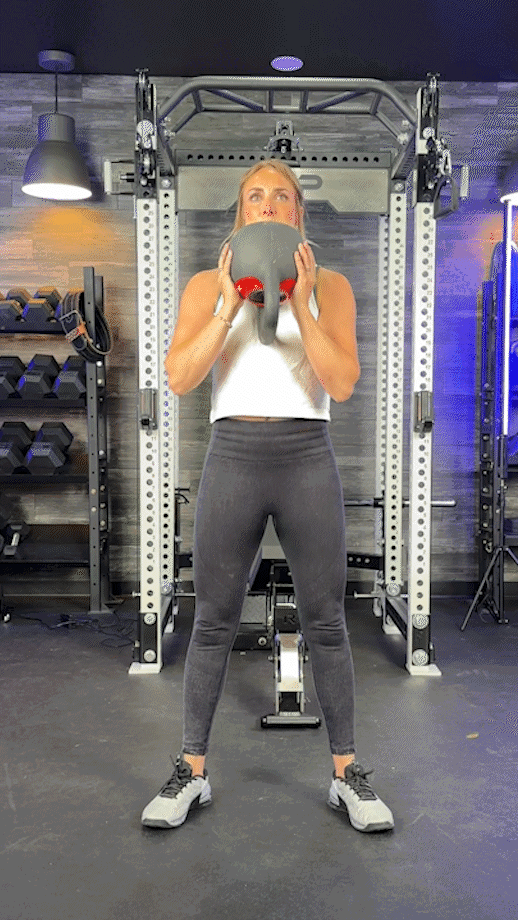
Kettlebell Reverse Alternating Lunge (Suitcase or Front Rack Hold)
Why we like it: “There are many lunge variations, but the reverse lunge is one of my favorites,” says Kate Meier, NASM-CPT, USAW-L1, CF-L1. “The movement builds lower body strength, namely in the hamstrings and glutes, and enables us to move explosively, which is harder to do with variations like walking lunges.”
How to do it:
- Hold one or two kettlebells either in the front rack position at shoulder height or using a suitcase grip. Start with your feet shoulder-width apart.
- Step your left leg behind you, bringing the left knee towards the floor as the right knee forms a 90-degree angle in front of you. If using one kettlebell, use your other hand as a counterbalance, and maintain a tall, strong posture.
- Lightly touch the floor with the left knee, then drive your right foot through the floor and bring your left foot back to center.
- Repeat the movement for the other side, alternating on each rep.
RELATED: Lunges Exercise
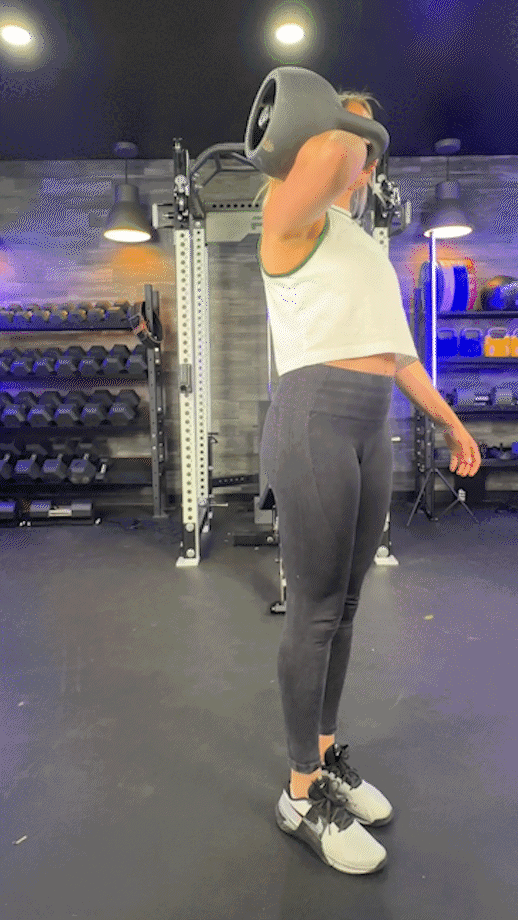
Kettlebell Bulgarian Split Squat (Suitcase Hold)
Why we like it: The Bulgarian split squat targets various muscles in the posterior chain, including the hamstrings, hip abductors, quadriceps, glutes, and erector spinae in the lower back. It’s a great exercise for improving mobility in your hips, knees, and ankles, too.
How to do it:
- Stand with a flat weight bench positioned horizontally behind you and a kettlebell in each hand.
- Place one foot on the bench behind you, then lower yourself into a split squat position by bending your front leg. Continue until your front knee forms a 90-degree angle.
- Push through your front heel to return to the starting position.
- Repeat as needed for reps, then switch sides.

Kettlebell Romanian Deadlift (RDL)
Why we like it: According to a 2020 review published in PLoS One1, the Romanian deadlift provides superior hamstring activation versus the conventional deadlift, making it a great inclusion to your lower body strength training session.
How to do it:
- Start with your feet hip-width apart and a kettlebell held in front of you with both hands.
- Push your hips back and lower the kettlebell towards the floor.
- Continue until you feel a stretch in your hamstrings.
- Push through your heels and return to standing.
RELATED: RDL Workout
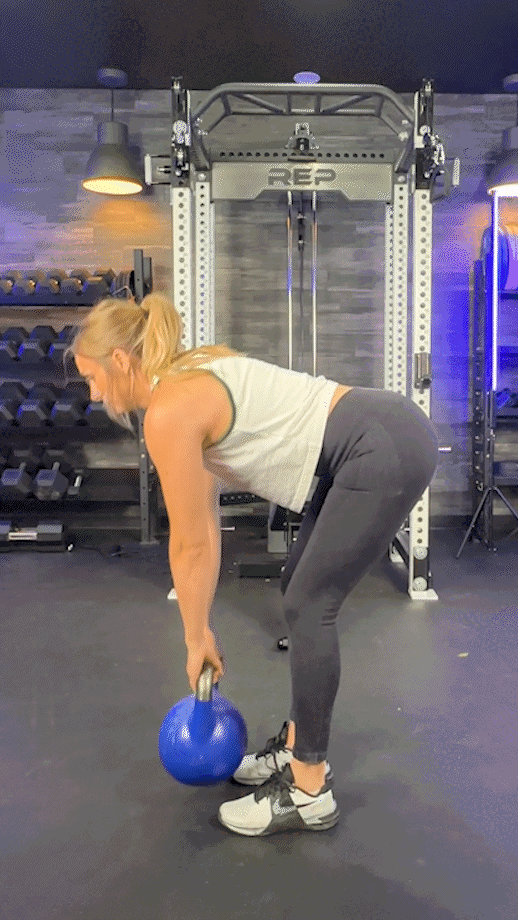
Kettlebell Single-Leg Romanian Deadlift
Why we like it: Performing a unilateral RDL helps correct imbalances with your leg muscles. According to a 2023 study published in Medicine and Science in Sports and Exercise2, this single leg deadlift variation is one of the best for activating the glutes.
How to do it:
- Start with your feet hip-width apart and a kettlebell held in front of you with both hands.
- Maintaining a slight bend in your working knee, bring your hips back and chest down towards the floor. Let your other leg rise into the air behind you as you descend.
- Continue until you feel a stretch, then push through your heel to stand up.
- Repeat as needed, then switch sides and repeat the whole set.
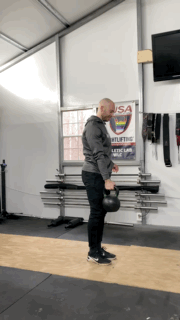
Kettlebell Hip Thrust
Why we like it: According to a 2019 review published in the Journal of Sports Science & Medicine3, the hip thrust is a great exercise for targeting the hip extensors, improving biomechanics for sports and daily life.
How to do it:
- Sit with your back to the weight bench and a kettlebell held in your lap.
- Keeping both feet firmly planted and your knees bent, thrust your hips upward to form a straight line with your shoulders, upper body, and hips.
- Squeeze your glutes, then slowly come down.
RELATED: Hip Thrust Workout

Kettlebell Single-Leg Hip Thrust
Why we like it: “Converting any bilateral exercise to a unilateral version takes away your ability to compensate,” says Kate. “That means you’ll build both sides equally, correcting imbalances.”
How to do it:
- Set up as you would for the regular kettlebell hip thrust.
- Lift one leg into the air, holding the knee high.
- Push your other foot into the floor and thrust your hips.
- Hold the peak position, then release.
- Repeat as needed, then switch sides and repeat the set.

Kettlebell Sumo Squat
Why we like it: This kettlebell squat variation is excellent for beginners due to its wider, more stable base. It’s a great lower body workout, improving strength, mobility, and posture.
How to do it:
- Hold a kettlebell with both hands in front of your body.
- Stand with your feet wider than shoulder-width.
- Squat until your thighs are parallel with the floor or the kettlebell touches the floor.
- Drive through your feet to return to a standing position.

Kettlebell Side Lunge
Why we like it: “The side lunge movement forces you to contract the adductors on each rep,” says Kate, “which improves hip mobility and flexibility. The movement also hits your hamstrings, quads, glutes, and abductors.”
How to do it:
- Hold a kettlebell in each hand and stand with your feet hip-width apart.
- Step to your left, leaning into your left knee as your right leg extends..
- Pause, then drive your left foot into the floor and step it back to center.
- Repeat the movement using your right foot.
- Alternate sides until the set is complete.

Kettlebell Front Squat (Front Rack)
Why we like it: Goblet squats are grand, but you’ll be capable of moving heavier weights with the kettlebell front squat because they’re held securely against your upper body.
How to do it:
- Hold one or two kettlebells in the front rack position at shoulder height.
- Keeping your back flat, core tight, and weight on your heels, push your hips back and bend your knees to squat. Continue until your thighs are parallel with the floor.
- Pause at the bottom, then drive from your heels to stand.
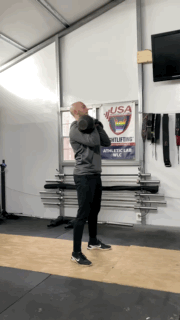
Russian Kettlebell Swing
Why we like it: Russian kettlebell swings provide a full-body kettlebell workout. You’ll get muscle activation throughout your entire body, and studies show4 that the compound movement features a significant cardiovascular demand. It’s also guaranteed to get your heart rate up there!
How to do it:
- Hold a kettlebell with both hands in front of your body.
- Slightly bend your knees and lean forward, then forcefully thrust your hips forward to drive the kettlebell into the air.
- Swing the kettlebell to chest height, then control it as you let it swing back down.
- Guide it between your legs and behind you, then thrust your hips forward to cycle into the next rep.
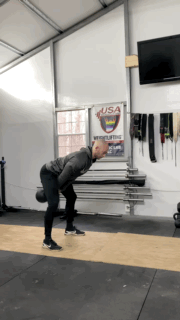
Create Your Kettlebell Leg Workout
These kettlebell leg workout exercises are awesome, but they’re even better with a well-structured workout routine catered to your fitness goals.
We’ve got workouts for building muscle, increasing strength, and improving power.
RELATED: How Many Reps to Build Muscle
Kettlebell Leg Workout for Hypertrophy
“If you’re looking to build muscle mass, we’ll want to use a moderate rep scheme and a kettlebell that presents a moderate challenge,” says Kate Meier, NASM-CPT, USAW-L1, CF-L1, and GGR Head of Content.
According to a 2021 review published in Sports (Basel)5, that means “8 to 12 repetitions per set with 60% to 80% of [your one-rep max].”
The weight should feel challenging, especially in the final reps of the set, but it should also allow you to perform the prescribed 8 to 12 reps with excellent form.
Here’s a workout designed for hypertrophic gains.
| Exercise | Sets | Reps |
| Goblet Squat | 3 to 6 | 8 to 12 |
| RDL | 3 to 6 | 8 to 12 |
| Side Lunge | 3 to 6 | 8 to 12 |
| Single-Leg Hip Thrust | 3 to 6 | 8 to 12 |
| Russian KB Swing | 3 to 6 | 8 to 12 |
Beginners should rest as needed, but those at an intermediate fitness level or higher should limit rest periods to one minute.
Kettlebell Leg Workout for Strength
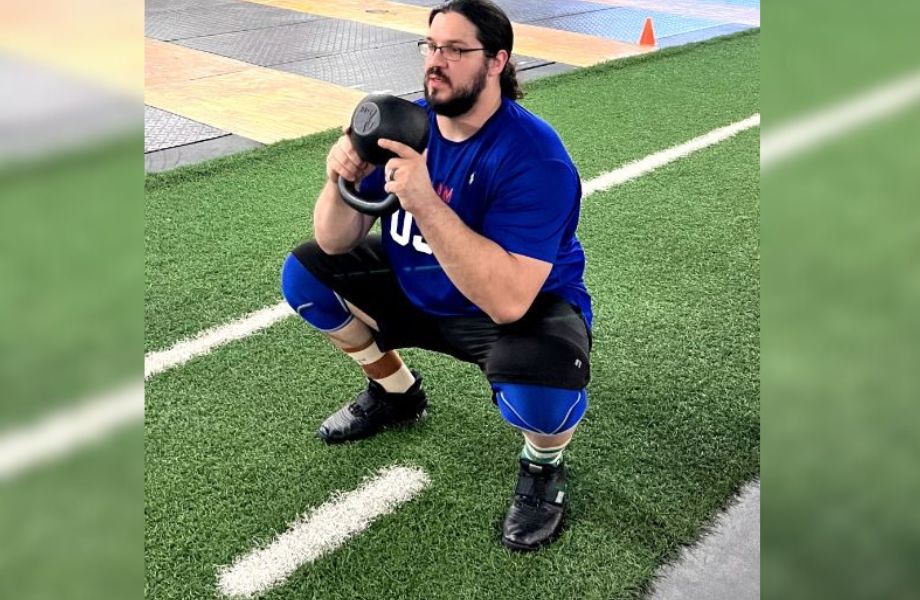
“For strength gains, performing less reps with heavier weights is ideal,” says Kate. “We’re only going to do between one and five reps, but we’re also going to use somewhere between 80% and 100% of your one-rep max. Instead of the last reps feeling challenging, every rep should be a challenge.”
| Exercise | Sets | Reps |
| Front Squat | 2 to 6 | 1 to 5 |
| Single-Leg RDL | 2 to 6 | 1 to 5 |
| Sumo Squat | 2 to 6 | 1 to 5 |
| Hip Thrust | 2 to 6 | 1 to 5 |
Take between one and three minutes of rest between sets and exercises. If you’re truly giving it your all on each set, you’ll need the time to recuperate for the next round.
Kettlebell Leg Workout for Power
A 2007 study published in the Journal of Strength and Conditioning Research6 observed “significant declines in power output…from the sixth repetition onwards,” so we want to use a moderate weight and a moderate number of reps for our power workout.
“The key is to move explosively through the eccentric phase of the movement,” says Kate. “Moving with intensity helps train fast-twitch muscle fibers, which contribute to increased power and explosiveness.”
| Exercise | Sets | Reps |
| Goblet Squat | 3 to 6 | 3 to 6 |
| Alternative Reverse Lunge | 3 to 6 | 3 to 6 |
| Bulgarian Split Squat | 3 to 6 | 3 to 6 |
| Hip Thrust | 3 to 6 | 3 to 6 |
| Side Lunge | 3 to 6 | 3 to 6 |
| Russian KB Swing | 3 to 6 | 8 to 12 |
As for rest, the standard 60 seconds applies, but take a little extra if it means the difference between eking out the next reps and really performing the movement with full intensity. You want the latter.
Benefits of Kettlebell Training for Legs
A single kettlebell unlocks the ability to do cardio, HIIT, and strength training without the need for massive machines, bulky barbells, and ridiculously-oversized racks that can eat up all the floor space of your home gym.
RELATED: HIIT Cardio Workout at Home
“Kettlebells are a simple way to add resistance to already effective bodyweight movements, compounding the overall effects,” says Kate Meier, NASM-CPT, USAW-L1, CF-L1. “It doesn’t matter if you’re looking to build size, strength, or endurance. Kettlebells can get you results if implemented properly.”
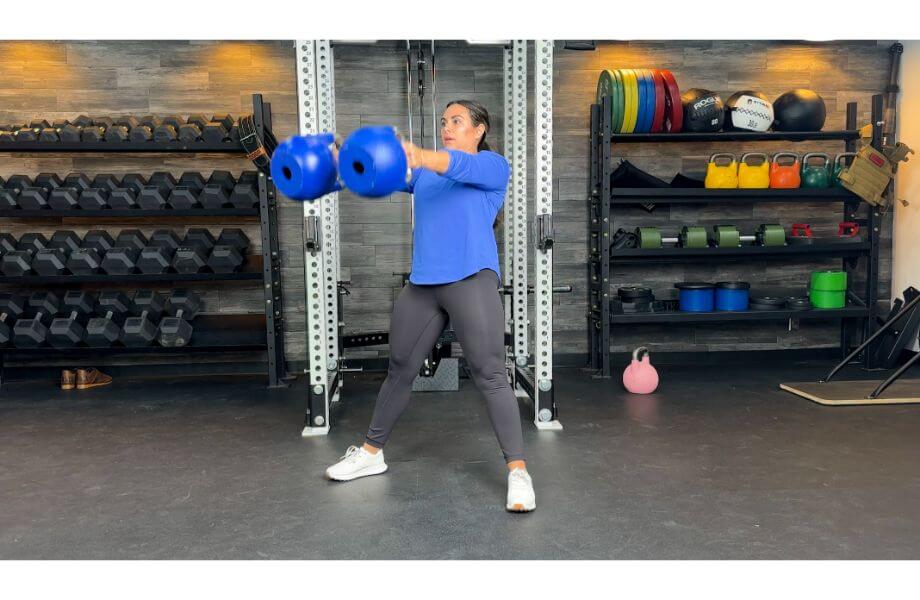
That’s fantastic if you’re looking for lower body exercises to do on leg day, but the benefits transcend beyond just the muscles.
A 2020 study published in the Journal of Bodywork and Movement Therapies7 found that twelve weeks of kettlebell training also showed improvements regarding mental health, including the ability “to reduce and prevent depressive/anxiety symptoms in healthy women.”
RELATED: 11 Kettlebell Benefits, According To An Olympian
So, kettlebell training is an easy win on leg day, but it boasts a wide variety of benefits that make it an excellent and effective training modality in general.
Kettlebell Leg Workout: Final Thoughts
From kettlebell deadlifts to split squats, side lunges, and swings, there’s a wide range of exercises available for your kettlebell leg workout.
Sprinkle some of Kate Meier’s (NASM-CPT, USAW-L1, CF-L1) picks into your next leg day workout, and see how you do!
Kettlebell Leg Workout: FAQs
Can you build your legs with kettlebells?
Kettlebells are endlessly versatile, and leg day exercises like kettlebell goblet squats, Romanian deadlifts, and Russian swings help prove that!
By incorporating kettlebells into functional movements like squats and lunges, you’re adding resistance, which increases the amount of work performed and makes the exercise more effective overall. So, you can most certainly build your legs using kettlebells.
“Any movement that provides activation to your lower body muscles like the glutes, quads, hamstrings, and calves will help build strength and size in the legs,” says Kate Meier, NASM-CPT, USAW-L1, CF-L1, and GGR Head of Content. “We typically associate these gains with barbells, but kettlebells offer a similar stimulus, making them a totally viable, alternative method of training.”
Do kettlebell swings strengthen legs?
If you’re performing the kettlebell swing with proper form, you’re mostly using your hips to thrust the kettlebell into the air and keep it moving. So, does that mean your legs are reaping any benefit, or is it all reserved for the hips since they bear the brunt of it?
“Kettlebell swings definitely strengthen the legs,” says Kate Meier, NASM-CPT, USAW-L1, CF-L1, and GGR Head of Content. “They provide activation in just about every lower body muscle group there is, meaning you will build strength and endurance from performing sets of kettlebell swings.”
Do kettlebell squats build quads?
Kettlebell exercises like the goblet squat target your quads, glutes, and calves, with the added bonus of incorporating your arm and core muscles. Variations like the kettlebell split squat and front squat also focus on the quad (and hamstring) muscles, helping you build strength and size when performed regularly.
References
1. Martín-Fuentes I, Oliva-Lozano JM, Muyor JM. Electromyographic activity in deadlift exercise and its variants. A systematic review. PLoS One. 2020;15(2):e0229507. Published 2020 Feb 27. doi:10.1371/journal.pone.0229507
2. Collings TJ, Bourne MN, Barrett RS, et al. Gluteal Muscle Forces during Hip-Focused Injury Prevention and Rehabilitation Exercises. Med Sci Sports Exerc. 2023;55(4):650-660. doi:10.1249/MSS.0000000000003091
3. Neto WK, Vieira TL, Gama EF. Barbell Hip Thrust, Muscular Activation and Performance: A Systematic Review. J Sports Sci Med. 2019;18(2):198-206. Published 2019 Jun 1.
4. Fortner HA, Salgado JM, Holmstrup AM, Holmstrup ME. Cardiovascular and Metabolic Demads of the Kettlebell Swing using Tabata Interval versus a Traditional Resistance Protocol. Int J Exerc Sci. 2014;7(3):179-185. Published 2014 Jul 1.
5. Schoenfeld BJ, Grgic J, Van Every DW, Plotkin DL. Loading Recommendations for Muscle Strength, Hypertrophy, and Local Endurance: A Re-Examination of the Repetition Continuum. Sports (Basel). 2021;9(2):32. Published 2021 Feb 22. doi:10.3390/sports9020032
6. Baker DG, Newton RU. Change in power output across a high-repetition set of bench throws and jump squats in highly trained athletes. J Strength Cond Res. 2007;21(4):1007-1011. doi:10.1519/R-22376.1
7. Rufo-Tavares W, Barbosa Lira CA, Andrade MS, et al. Effects of kettlebell training and detraining on mood status and sleep and life quality of healthy women. J Bodyw Mov Ther. 2020;24(4):344-353. doi:10.1016/j.jbmt.2020.07.006


